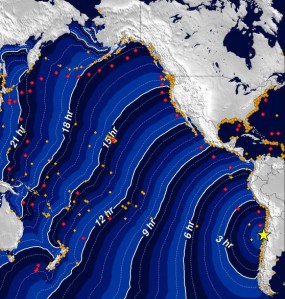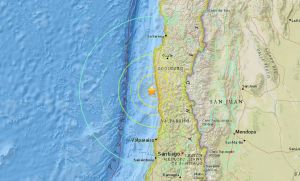A tsunami advisory was issued for the California coastline after a deadly 8.3-magnitude earthquake struck off Chile’s coast on Wednesday and was followed by multiple strong aftershocks.

The advisory was in effect from San Onofre State Beach in Orange County to Ragged Point in San Luis Obispo County, where waves of up to 1 foot above the tide line were possible beginning at around 4:45 a.m. on Thursday, according to the Pacific Tsunami Warning Center.
The local advisory referred to a tsunami capable of producing strong currents or waves that could be considered dangerous to swimmers, boaters or property.
Widespread inundation was not expected, the National Weather Service stated on its Facebook page, but strong currents and surges were likely in many areas.
The strongest surges and currents were expected to occur at high tide, the post stated. “Harbors and marinas will be especially dangerous throughout this event. In addition, there will be a high rip current risk,” the post continued.
The tsunami advisory prompted the Orange County Sheriff’s Department to close all beaches, marinas and harbors as a precaution. No evacuations were ordered.
No closures were ordered in Los Angeles or Ventura counties, where authorities urged residents to use caution.

In Chile, the epicenter of the 8.3-magnitude quake was located about 34 miles west of the inland town of Illapel, Chile, the U.S. Geological Center said. It occurred around 3:54 p.m. PT and had a depth of 15.5 miles.
Illapel is about 130 miles north of Chile’s capital, Santiago.
It was initially reported as a magnitude-7.9 quake, but that was upgraded to 8.3, according to USGS.
At least five people were killed in the quake, President Michelle Bachelet said. The victims included a 35-year-old woman who was killed by a falling roof, a 20-year-old woman who was killed by falling rocks and a man in his 80s who suffered a heart attack.
There were also reports of damage to homes and businesses in Illapel, Interior Minister Jorge Burgos told reporters.
In La Serena, a coastal city just north of Coquimbo, pictures taken at a shopping mall showed walls and signs toppled to the floor, ceiling tiles caved in as well as chairs, benches and tables covered in rubble.
Coquimbo Mayor Cristian Galleguillos told CNN Chile that 95 percent of the city had lost electrical power. Residents evacuated before waves started hitting the coastline, he said.
The initial quake was followed at 3:59 p.m., by a magnitude-6.3 quake 44 miles west Illapel.
About 20 minutes later, at 4:18 p.m. PT, a magnitude-6.4 earthquake struck. That temblor’s epicenter was below land, about 16 miles west of Illapel.

USGS indicated there were multiple other aftershocks as well.
At least one strong aftershock could be felt in the country’s capital, CNN Chile reported.
“Everybody ran outside. The windows rattled. Things fell. The impact was strong,” said Emily Hersh, who lives in Santiago. “Even after I stepped outside, I felt the ground moving.”
The earthquake hit during rush hour, causing traffic snarls that left many people stuck in the streets as they tried to get home, said Fabrizio Guzman, emergency communications manager for World Vision in Chile.
“There were many people afraid, running in the streets, when the shaking started,” he said in a statement. “The earthquake felt really intense and seemed to last for several minutes.”
Chile’s national emergency agency issued a tsunami warning, ordering the evacuation of one million people in coastal areas from Arica to Puerto Aysen.
Waves up to nearly 10 feet above the tide line were possible in Chile, the Pacific Tsunami Warning Center announced.
In Coquimbo, one wave was measured at more than 15 feet high, according to the U.S. National Tsunami Warning center.
Other areas with Pacific-facing coastlines could expect to see waves of more than 3 feet above the tide line, including Mexico, Russia, New Zealand, Hawaii and many other Pacific islands.
Chile sits on an arc of volcanoes and fault lines circling the Pacific Ocean known as the “Ring of Fire.” The area experiences frequent earthquakes and volcanic eruptions.
Since 1973, Chile has had more than a dozen quakes of magnitude-7.0 and above.
Modeled tsunami travel times. The wave from the Chile earthquake will arrive in ~13 hours, or ~5 AM Thursday. pic.twitter.com/gmzgVWy56i
— NWS Los Angeles (@NWSLosAngeles) September 17, 2015
More Video:














